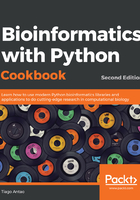
上QQ阅读APP看书,第一时间看更新
There's more...
Much more can be said about the management of sequences in Biopython, but this is mostly introductory material that you can find in the Biopython tutorial. I think it's important to give you a taste of sequence management, mostly for completion purposes. To support readers who might have some experience in other fields of bioinformatics, but are just starting with sequence analysis, there are, nonetheless, a few points that you should be aware of:
- When you perform a RNA translation to get your protein, be sure to use the correct genetic code. Even if you are working with "common" organisms (such as humans), remember that the mitochondrial genetic code is different.
- Biopython's Seq object is much more flexible than what's shown here. For some good examples, refer to the Biopython tutorial. However, this recipe will be enough for the work we need to do with FASTQ files (see the next recipe).
- To deal with strand-related issues, there are, as expected, sequence functions like reverse_complement.